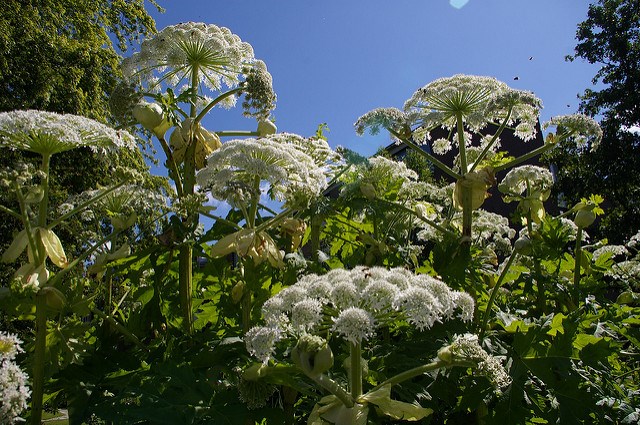Forget the war on drugs — welcome to the war on weeds.
Not the kind of weed that gives you a high, but the kind that can choke agriculture, cause burns, blindness, and the destruction of sidewalks and streets.
The Squamish-Lillooet Regional District is on the cusp of adopting bylaws targeting invasive species of plants.
But before passing one of these proposed regulations, the regional district is asking for your permission, first.
That proposal would initially funnel up to $50,000 to two non-profit organizations that combat pesky plants, followed by up to $75,000 each year afterwards.
If the public accepts Bylaw No. 1541-2017, that money would be given to the Lillooet Regional Invasive Species Society and the Sea to Sky Invasive Species Council.
In turn, these organizations would be expected to clamp down on the growth of invasive plants in the regional district.
While these groups already receive funding from the SLRD, this comes in the form of area director select funding, which can be subject to change each year, said Clare Greenberg, executive director of the Sea to Sky Invasive Species Council.
It’s hoped this new bylaw will stabilize cash flow over a longer period.
“Most invasive plants require more than one season of control,” said Greenberg.
“It’s really important to have a stable sort of long term plan. If we only have confirmation of funds 12 months in advance, we can only plan for that one year. But if we know that we’re going to have stable funding...we can really plan strategically.”
As a result, an alternative approval process has been started, giving residents of the SLRD until Nov. 27, a chance to say ‘no’ to the idea.
If 3,678 residents give the proposal a thumbs-down, the bylaw will not go forward. However, should less than that number object, the new regulations will be adopted.
Under the bylaw, a maximum of $15,000 will be taxed from the District of Squamish to fund the initiative. Another $15,000 will be taken from Area D, which includes areas surrounding Squamish, such as Britannia Beach.
Whistler and Area C – the zone surrounding Whistler and Pemberton – will each have to pay the same amount as well.
The rest will be divvied up between Pemberton, Lillooet, Area A and Area B.
On a per property basis, Squamish residents can expect to pay $0.21 for every $100,000 of property they own.
For Area D residents, this would be $1.41.
The funds will be spent on ground operations, which can include removing invasive plants by hand, through herbicide, or other measures.
Cash will also be used to survey areas for invasive species, and for education and outreach programs to educate the public on how to stifle the spread of weeds.
Greenberg said much headway has been made in controlling the top 20 invasive species, but given that there are at least 200 invasive weeds in the SLRD, there’s much work to do.
Some notable targets include orange hawkweed, which chokes up farmland, and knotweed, which causes cracks in sidewalks and roads.
Giant hogweed tops the society’s hit list, because it can cause symptoms of burning and even blindness in humans.
“That affects our tourism economy,” said Greenberg. “That affects our own enjoyment of our own environment. The other impacts can be agricultural and economical.”
Residents can weigh in on the alternative approval process for this bylaw at slrd.bc.ca.
Also on the SLRD’s agenda is a separate bylaw that does not require public consent to pass, because it doesn’t create what’s considered a “general service” under law, which the previous proposed bylaw 1541-2017 does.
Instead, this potential bylaw, called 1542-2017, calls on residents to clamp down on invasive plants growing on their own property.
“Every owner or occupier of real property within the control area shall ensure that his or her real property be cleared of and remain free from all noxious weeds,” reads the proposed bylaw.
An information report presented to the regional district board said planners initially considered using more subjective language, asking residents to keep their yards “reasonably” clear, but there was worry that this could open up the SLRD to legal challenges.
However, to avoid going too hard on residents, the information report said the bylaw officer will “exercise discretion” and distinguish between minor and severe offenders.
A 14-day notification period will also give residents a chance to remove the weeds before they get fined.
The cost of a violation ticket hasn’t been determined, but staffers have suggested creating a $200 penalty.
The SLRD employs only one part-time bylaw officer, but is exploring the idea of creating a shared bylaw service for Area D and the District of Squamish.



